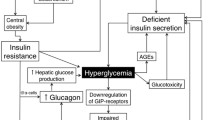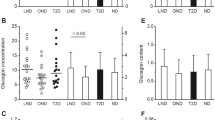Abstract
A significant weight gain and increase in serum leptin levels in the course of antiepileptic treatment with valproic acid has been described in several clinical studies. With respect to the long treatment period in antiepileptic therapy, these side effects might increase insulin resistance and metabolic risk factors. The effect of valproate on insulin secretion in pancreatic islet cells was studied in in vitro experiments with islets from pancreases of multiorgan donors. It can be speculated that an increase in pancreatic insulin secretion under chronic valproate treatment enhances appetite and energy storage and is related to the observed weight gain. Changes in weight seem to affect the expression of PCOS in women with PCO, with a gain in weight being associated with a worsening of the symptoms of PCOS. Nonalcoholic fatty liver disease was defined recently as another symptom of insulin resistance in valproate treated patients. Leptin secreted from peripheral adipose tissue acts centrally within the mammalian hypothalamus to reduce appetite and promote a negative energy balance, as observed in Topiramate-treated patients. Elevated circulating leptin concentrations in obese humans fail to act in this way.
Zusammenfassung
Insulin, ein Hormon des endokrinen Pankreas, kann durch eine antiepileptische Therapie mit Valproat vermehrt aus den β-Zellen sezerniert werden. Experimentelle Studien geben Hinweise für eine direkte Wirkung von Valproat auf die β-Zellen des Pankreas. Die Folge sind eine Hyperinsulinämie und später eine Insulinresistenz, die wiederum streng mit einer Gewichtszunahme und einem möglichen metabolischen Syndrom einhergeht. Bei weiblichen Patienten kann die Umverteilung des Körperfettgewebes, vom gynoiden zum androiden Typus (Stammfettsucht), auch die Entstehung eines polyzystischen Ovar-Syndroms begünstigen. Durch den Einfluss auf den Fettstoffwechsel in der Leber kann die Entstehung einer nicht alkoholischen Fettleber eine zusätzliche Langzeitnebenwirkung von Valproat sein. Leptin, ein Proteohormon, wird aus den Fettzellen sezerniert und steht ebenso im engen Zusammenhang mit einer antiepileptischen Therapie mit Valproat und einer Körpergewichtszunahme. Da es eine zentrale Appetithemmung erzeugt, wurden diesbezüglich auch Untersuchungen mit Topiramat durchgeführt.
Similar content being viewed by others
References
Bergmann RN, Ider YZ, Bowden CR (1979) Quantitative estimation of insulin sensitivity. Am J Physiol 236:667–677
Biton V, Mirza W, Montouris G et al (2001) Weight gain associated with valproate and lamotrigine monotherapy in patients with epilepsy. Neurology 56:172–177
Breum L, Astrup A, Gram L et al (1992) Metabolic changes through treatment with valproate in humans: Implications for untoward weight gain. Metabolism 41:666–670
Büchler MW, Uhl W, Malfertheiner P (2004) Pankreaserkrankungen. Akute Pankreatitis, Chronische Pankreatitis, Tumore des Pankreas. Karger, Basel
Campfield LS, Smith FJ, Burn P (1996) The OB protein (leptin) pathway: a link between adipose tissue mass and central neural networks. Horm Metab Res 28:619–632
Cassader M, Gambino R, Depetris N et al (2001) Postprandial triglyceriderich lipoprotein metabolism and insulin sensitivity in nonalcoholic steatohepatitis patients. Lipids 36:117–1124
Dandona P, Aljada A, Bandyopadhyay A (2004) Inflammation: the link between insulin resistance, obesity and diabetes. Trend Immunol 25(1):4–7
Dinesen H, Gram L, Andersen T et al (1984) Weight gain during treatment with valproate. Acta Neurol Scand 69:65–69
Friedman JM, Halaas JL (1998) Leptin and the regulation of body weight in mammals. Nature 395:763–770
Isojärvi JIT, LaatikainenTJ, Pakarinen AJ, Juntunen KTS, Myllyla VV (1993) Polycystic ovaries and hyperandrogenism in women taking valproate for epilepsy. N Engl J Med 329:1383–1388
Isojärvi JI, Laatikainen TJ, Knip M et al (1996) Obesity and endocrine disorders in women taking valproate for epilepsy. Ann Neurol 39:579–584
Isojärvi JI, Rattya J, Myllyla VV et al (1998) Valproate, lamotrigine, and insulin mediated risks in women with epilepsy. Ann Neurol 43:446–451
Luef G, Abraham I, Haslinger M et al (2002) Polycystic ovaries, obesity and insulin resistance in women with epilepsy: a comparative study of carbamazepine and valproic acid in 105 women: J Neurol 249:835–841
Luef G, Abraham I, Trinka E et al (2002) Hyperandrogenism, postprandial hyperinsulism and the risk of PCOS in a cross sectional study of women with epilepsy treated with valproate. Epilepsy Res 48:91–102
Luef G, Abraham I, Hoppichler F et al (2002) Increase in postprandial serum insulin levels in epileptic patients with valproic acid therapy. Metabolism 10:1274–1278
Luef G, Lechleitner M, Bauer G, Hengster P (2003) Valproic acid modulates islet cell insulin secretion: a possible mechanism of weight gain in epilepsy patients. Epilepsy Res 55:53–58
Luef GJ, Waldmann M, Sturm W et al (2004) Valproat therapy and nonalcoholic fatty liver disease. Ann Neurol 55:729–732
Messenheimer J (2003) Higher androgens and weight gain with valproate compared with lamotrigine for epilepsy. Epilepsy Res 54:189–199
Morrell M, Isojärvi J, Taylor AE et al (2002) Serum insulin and leptin levels in valproate-associated obesity. Epilepsia 43:514–517
Rett K (1999) The relation between insulin resistance and cardiovascular complications of the insulin resistance syndrome. Diab Obes Metab 1(Suppl 1):8–16
Verrotti A, Basciani F, De Simone M et al (2002) Insulin resistance in epileptic girls who gain weight after therapy with valproic acid. J Child Neurol 17:265–268
Author information
Authors and Affiliations
Corresponding author
Rights and permissions
About this article
Cite this article
Luef, G. Pankreashormone und Leptin. Z. Epileptol. 19, 195–198 (2006). https://doi.org/10.1007/s10309-006-0209-x
Received:
Accepted:
Issue Date:
DOI: https://doi.org/10.1007/s10309-006-0209-x




